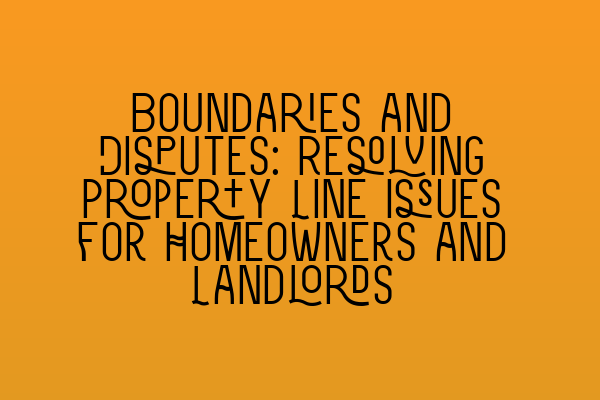As a solicitor specializing in property law, I am often approached by homeowners and landlords who find themselves in disputes over property boundaries. These conflicts can arise due to various reasons, such as unclear or disputed boundary lines, encroachments by neighboring properties, or disagreements over the use and maintenance of shared areas.
In this comprehensive blog post, I will walk you through the process of resolving property line issues, providing you with valuable insights and practical tips to help you navigate through this complex legal terrain. Whether you are a homeowner or a landlord, understanding the intricacies of boundary disputes can save you time, money, and unnecessary stress.
Understanding Boundaries
Before we delve into resolving property line issues, it is essential to have a clear understanding of what a boundary is. A property boundary refers to the line that separates one parcel of land from another, establishing the extent of an individual’s ownership or rights. These boundaries can be physical, such as fences, walls, or hedges, or they can be legal boundaries based on conveyance documents or local ordinances.
Often, property owners rely on their title deeds to determine the exact location of their boundaries. However, in some cases, these documents may not provide sufficient clarity or accuracy, leading to disputes between neighbors. This is where the expertise of a property law solicitor becomes invaluable.
The Importance of Resolving Boundary Disputes
Boundary disputes can have significant implications for homeowners and landlords. They can affect property values, limit the use and enjoyment of land, and even lead to legal complications when selling or mortgaging a property. Therefore, it is essential to address these disputes promptly and effectively.
Resolving boundary issues can prevent future conflicts, improve neighborly relations, and ensure a smooth transfer of property rights. Additionally, resolving a dispute through legal means can provide you with the necessary legal protection and ensure that your interests are safeguarded.
Steps to Resolving Property Line Issues
1. Communication: The first step in resolving any boundary dispute is to open a line of communication with your neighbor. In many cases, misunderstandings or misconceptions can be cleared up through a simple conversation. Discuss the issue openly, present your concerns, and listen to your neighbor’s perspective. Keeping communication respectful and non-confrontational is key to finding a resolution.
2. Evidence Gathering: If the initial communication does not lead to a resolution, it is crucial to gather evidence to support your claim. This may include reviewing your title deeds, conducting a land survey, taking photographs of the disputed area, and gathering any relevant historical documentation. An experienced property law solicitor can assist you in collecting and analyzing the evidence to strengthen your case.
3. Mediation: If direct negotiations fail, mediation can be a useful tool for resolving boundary disputes. A neutral third party, such as a mediator or a surveyor, can facilitate a discussion between the parties involved and help them reach a mutually acceptable agreement. Mediation is often a cost-effective and less adversarial alternative to litigation, allowing for a quicker resolution of the dispute.
4. Legal Action: If all other avenues have been exhausted, initiating legal action may be necessary to resolve the boundary dispute. This typically involves filing a claim in court and presenting your case before a judge. It is crucial to have a skilled property law solicitor representing you throughout the litigation process to ensure your rights are protected and your arguments are presented effectively.
While each case is unique, following these steps can provide you with a roadmap to resolve your property line issues effectively. It is important to seek professional legal advice at every stage to maximize your chances of success.
The Role of Title Deeds and Surveys
In boundary disputes, title deeds and surveys play a critical role in determining the true location of a property boundary. Title deeds provide information about the legal ownership and rights associated with a property, while surveys use precise measurements to establish the physical boundaries on the ground.
Your title deeds may contain detailed descriptions or plans that define the extent of your property. However, these documents can sometimes be ambiguous or outdated, leading to boundary disputes. In such cases, a land survey carried out by a qualified professional can help clarify the exact location of your property boundaries.
It is important to note that surveys are admissible as evidence in court and can significantly influence the outcome of a boundary dispute. Therefore, investing in a professional land survey can strengthen your position and provide you with a solid foundation for resolving the issue.
Conclusion
Boundary disputes can be stressful and time-consuming for homeowners and landlords. However, with the right approach and guidance from a property law solicitor, these issues can be resolved efficiently and effectively.
By following the steps outlined in this blog post, including communication, evidence gathering, mediation, and legal action when necessary, you can protect your property rights and ensure a fair resolution to your boundary dispute.
If you require legal assistance in resolving a property line issue or have any other property law concern, do not hesitate to contact our team at SQE Property Law & Land Law. We have the expertise and experience to provide you with the guidance and support you need.
Related Articles:
- Misrepresentation in Contracts: Unveiling Deceptive Practices
- A Closer Look at SQE Contract Law Syllabus
- SQE Contract Law: Analyzing Landmark Cases and Influential Judicial Decisions
- Contract Law for Services: Key Considerations and Best Practices
- Understanding Contractual Capacity: Rights and Limitations
